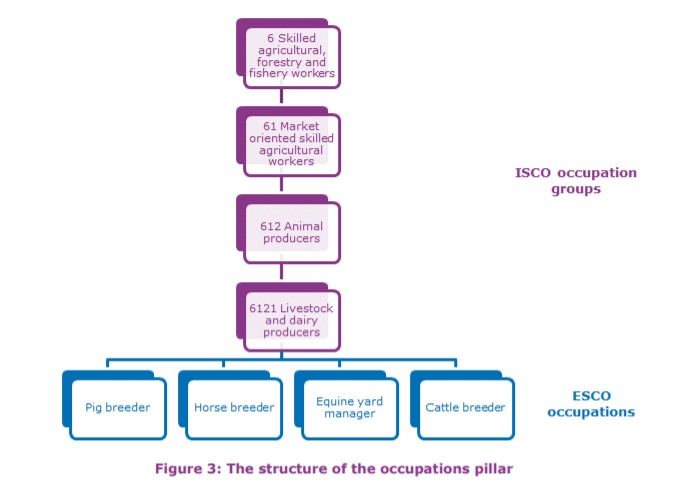Hierarchy view
ESCOpedia
The International Standard Classification of Occupations (ISCO) is a four-level classification of occupation groups managed by the International Labour Organisation (ILO). Its structure follows a grouping by education level. The two latest versions of ISCO are ISCO-88 (dating from 1988) and ISCO-08 (dating from 2008).
Contents
- 1. ESCO and ISCO
- 2. Translations of ISCO
- 3. Acknowledgement
- 4. Additional Documentation
1. ESCO and ISCO
In ESCO, each occupation is mapped to exactly one ISCO-08 code. ISCO-08 can therefore be used as a hierarchical structure for the occupations pillar. ISCO-08 provides the top four levels for the occupations pillar. ESCO occupations are located at level 5 and lower.
This drawing illustrates the role of ISCO 08 in the hierarchical structure of the ESCO occupations pillar:

Since ISCO is a statistical classification, its occupation groups do not overlap. Each ESCO occupation is therefore mapped to only one ISCO unit group. It follows from this structure, that ESCO occupation concepts can be equal to or narrower than ISCO unit groups, but not broader. The result is a strictly mono-hierarchical structure where each element at level 2 or lower has exactly one parent.
A few groups of ISCO-08 do not contain ESCO occupations. These are usually occupation groups with no economic activity in the EU, such as "water and firewood collectors".
2. Translations of ISCO
ESCO does not adapt the ISCO occupation groups, but the Commission manages translations of ISCO labels in the official languages of the European Union. For the various language variants ESCO uses the translations of the Commission Recommendation of 29 October 2009 on the use of the International Standard Classification of Occupations (2009/824/EC) if available.
3. Acknowledgement
Information and data in ESCO is based on an original work published by the ILO under the title International Standard Classification of Occupations, ISCO-08. Structure, Group Definitions and Correspondence Tables. Copyright © 2012 International Labour Organization. Adapted and reproduced with permission.
The responsibility for opinions expressed in studies and other contributions rests solely with their authors, and publication does not constitute an endorsement by the International Labour Office of the opinions expressed in them. Reference to names of firms and commercial products and processes does not imply their endorsement by the International Labour Office, and any failure to mention a particular firm, commercial product or process is not a sign of disapproval.
4. Additional documentation
For further insights visit the following links:
